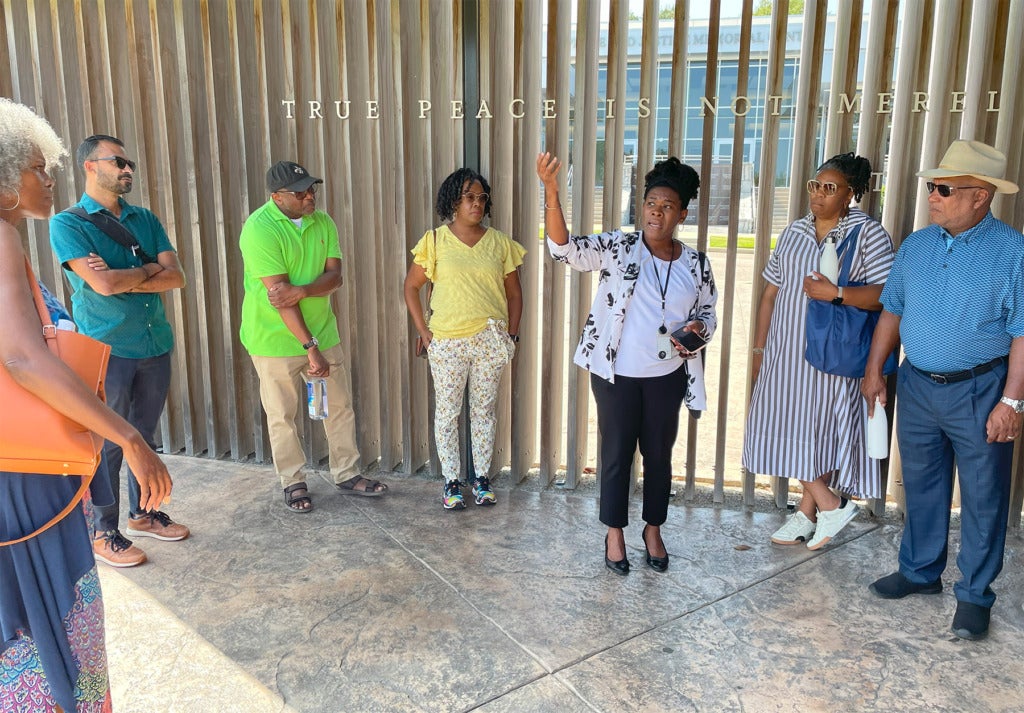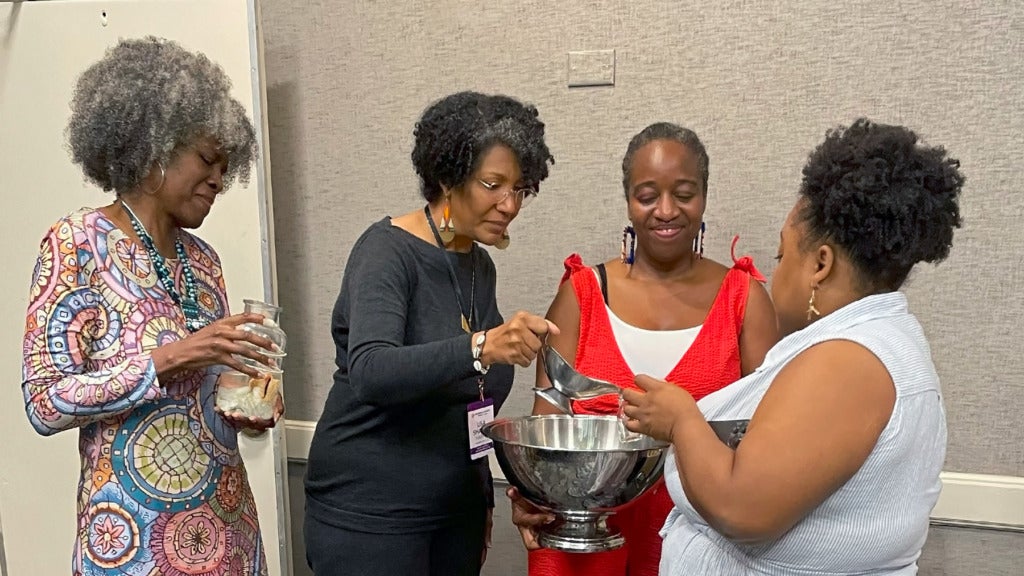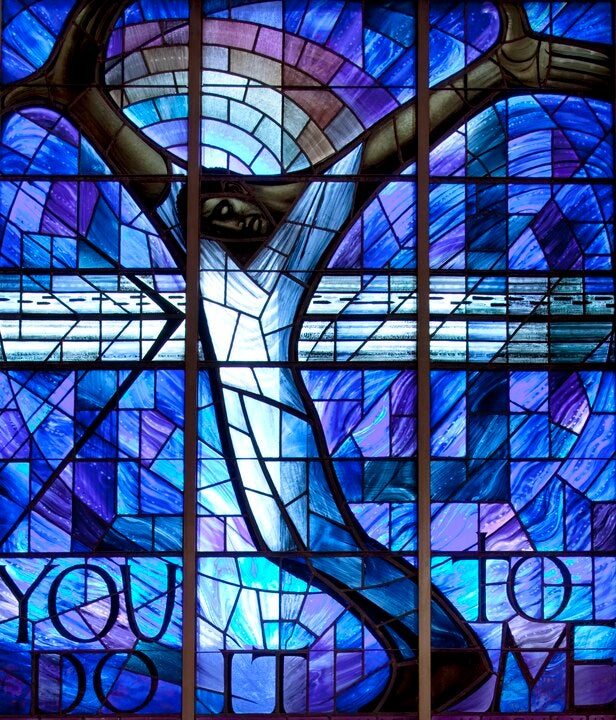“I planted the seed, Apollos watered it, but God has been making it grow. So neither the one who plants nor the one who waters is anything, but only God, who makes things grow. The one who plants and the one who waters have one purpose, and they will each be rewarded according to their own labor. For we are co-workers in God’s service; you are God’s field, God’s building.”
1 Corinthians 3:6-9
Faith leaders like the Rev. Fred Shuttlesworth and Rev. Lamar Weaver watered the seeds that the Rev. Dr. Martin Luther King, Jr. planted. Women like Coretta Scott King, Rosa Parks, and Pauli Murray watered and tended the sprouts that grew into the roots of the civil rights movement. The divine gave the increase.
The Aspen Institute Religion & Society Program’s Racial Justice & Religion Collective made a pilgrimage to Birmingham and Montgomery, Alabama on October 1-5, 2023. During this time, the attendees immersed themselves in history through museum visits, courageous conversations, and engaging with faithful elders who were in the civil rights movement.

Ekemini Uwan, Religion & Society Program senior adviser and Collective member, reflected on how the pilgrimage impacted her.
“Walking in the ancestors’ footsteps was harrowing, transformative, and powerful. The pilgrimage blessed me beyond measure,” Uwan said.
The Collective began their journey at the Alabama River’s bank, where slave traders transported enslaved Africans, specifically bred to sustain U.S. domestic slave trade, to Montgomery’s port.
Freedom Road Founder and President, Lisa Sharon Harper, and her team, Rev. Dr. Waltrina Middleton and Claudia Owens, led rituals at the riverbank that grounded the group and honored the spirits of the ancestors who surrounded us.
This curated experience focused on the impact of racial injustice on people of African descent in the United States. Harper said having the Collective walk through a cohesive story of the development of the political construct of Black people on U.S. soil was the pilgrimage’s aim.
“Our hope was that [the Collective left] with a sense that they have been transformed,” she said, [and that] their spirits have been spoken to by God about the hierarchies of human belonging.”
Collective members walked to a beautiful fountain in downtown Montgomery. That fountain now sits in the space once occupied by Montgomery’s bustling slave market, where the human hierarchy of belonging was put on display in a humiliating, dehumanizing, and demoralizing way.
Today, a historic marker noting the space once occupied by the slave market, stands discreetly across the street. One must actively look for any mention of the dehumanizing and demoralizing activity that once took place at the very spot.
A Rosa Parks statue, that stands across from the fountain, falsely portrays the historic giant and Alpha Kappa Alpha Sorority, Inc. member as meek and mild. “Just 5-foot-3, Parks stood tall for her personal rights and the liberties of others that were denied by segregationist Jim Crow laws,” Collective member Larita Rice-Barnes noted, countering the false narrative.
Collective member Russell Jeung reflected on how learning about the atrocities and inhumane treatment of Black people in the United States impacted him. “The pilgrimage haunted me as I walked where the enslaved were led to their auctioning blocks, sat with survivors of KKK bombings, and grieved over the thousands of lynching sites throughout the American South,” Jeung said. “I am more committed than ever in disrupting the binary of White Supremacy and Black abjection as our racial narrative.”
That racial narrative was brought to life during the Collective’s visit to the Legacy Museum. Vivid images of the transatlantic slave trade, the U.S. domestic slave trade, the scourge of lynching, the evils of Jim Crow, and the realities of the new Jim Crow—mass incarceration—left Collective members grappling with grim atrocities within American history.
However, Collective members also experienced moments of hope at the Legacy Museum, walking through a gallery of accomplished ancestors and passing images of laughing children as they left the space dedicated to Black lives.
That readied them to visit a moving monument to lynching victims and an informative visit with an Equal Justice Initiative staff member.
Harper, Middleton, and Owens created rituals that helped Collective members honor the memories of the ancestors and process our reactions surfaced during our pilgrimage in Montgomery.
Middleton gathered water from the Alabama River, where the bones of enslaved Africans who refused to die in bondage laid on its floor. After blessing the water, Collective members were invited to fill small jars with the water, embodying the living memory of those ancestors. Hearts with the names of beloved ancestors written by Collective members were affixed to each jar, allowing Collective members to remember on whose shoulders they stand.

These rituals prepared us to head to Birmingham.
The Collective members received a personal invitation to the home of Barbara Shores, daughter of renowned civil rights attorney Arthur Shores. During their visit, they listened intently to the moving and personal stories Mrs. Shores shared.
She painted vivid images of how the fight for Black liberation affected her family and the nation. She said Mr. Shores, who passed the Alabama bar exam in 1937, wasn’t the state’s first Black attorney, but he was the first Black attorney to argue a case in court. He represented labor leader William Hall, who’d been beaten by the police and won.
“Everybody was shocked and surprised,” she said. “When they were outside, people were coming up to congratulate him…A man came up and my father extended his hand because everybody was shaking his hand. Well, the man took a swing at him.”
Winning that case, she said, earned Arthur Shores the reputation of being a Black attorney not afraid of going into court to fight for justice.
Shores also recalled her sister, Helen, playing “cowboy” as a little girl with future U.S. Supreme Court Justice Thurgood Marshall. Helen was the cowgirl, and Marshall was the horse.
Other stories weren’t so sweet. Shores chronicled her family narrowly escaping their bombed house. Routine bombings earned the neighborhood the moniker Dynamite Hill.
Another bombing at the 16th Baptist Church made an indelible mark on the nation. The Rev. Arthur Price, Jr., its senior pastor, shared context about that terrible tragedy and its ongoing impact. A short film provided more context.
Following the film, Collective members ascended the same red padded stairway that Addie Mae Collins, Sarah Collins Rudolph, Cynthia Wesley, Carole Robertson, and Denise McNair ran down to see the sanctuary.

Like Sarah, a church window featuring Jesus didn’t survive the blast unscathed. A new window, complete with a rainbow and paid for by Welsh schoolchildren, continues to radiate hope:

The George F. Landegger Collection of Alabama Photographs in Carol M. Highsmith’s America, Library of Congress, Prints and Photographs Division
A tour of the Birmingham Civil Rights Institute and a gathering with the Community Foundation of Greater Birmingham, which included screening a short film, completed the transformative experience for the Collective.
Collective member Michael Mata shared a reflection about his experience.
“Although I have been to Montgomery before, our visit to the Legacy Museum underscored that reality/truth that the US of A (its economic vitality) was built on the backs of enslaved people,” Mata said. “I conceptually knew that, but the museum made that clear. Also, it gave me ‘new’ vocabulary – ‘Kidnapped’ was added to my previous takeaway of ‘enslaved’ rather than ‘slaves.’”
Mata stressed the inconvenient and sinful truth that enslaved Africans were considered less than human. Learning that both infants and children were lynched and all those barbaric acts were publicized deeply affected all the attendees.
Learning more about the evils of the transatlantic slave trade, Jim Crow, lynching, and mass incarceration allowed the religiously pluralistic group to develop a shared common voice to speak out more clearly against oppression.

